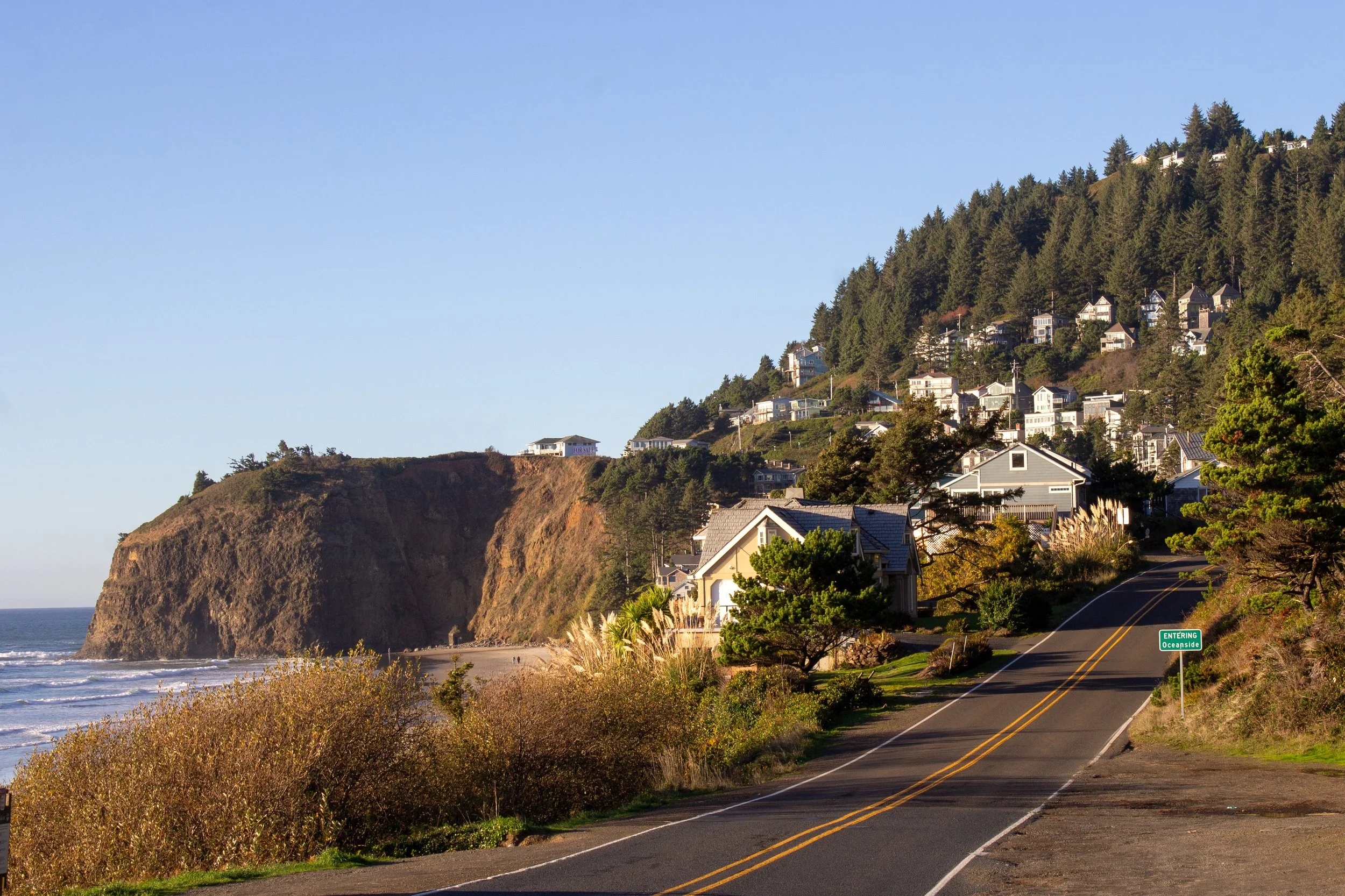Mysterious Neskowin Ghost Forest
When the tide recedes, ghosts emerge on the Oregon Coast. Barnacle-encrusted stumps appear above the waves, relics of a prehistoric forest buried long ago by encroaching sand. One of the most impressive and easiest-to-reach ghost forests on the Oregon Coast is at Neskowin Beach, where you can see dozens of 2,000-year-old Sitka spruce stumps year-round at low tide. Unlike many Oregon beaches, Neskowin rarely gets crowded. Its seclusion adds to the otherworldly atmosphere of the ghost forest. I visited several times. Each time feels like discovering a hidden world where mermaids and sea monsters dwell. Here is everything you need to about visiting the Neskowin Ghost Forest.
Ancient stump in the Neskowin Ghost Forest
Know before you go
It’s free to visit Neskowin Beach and the Ghost Forest. You don’t need a pass to park.
Neskowin Beach is dog-friendly.
Restrooms and picnic tables are by the parking lot. They’re about a quarter mile from the beach. I’d bring a picnic to the beach since the tables just look at the parked cars.
Plan your visit at a low to medium tide to see the Neskowin Ghost Forest. Waves cover the stumps at high tide. Tide tables like this one help predict when to expect high and low tides. The tide doesn’t need to be very low to see it, just under +5 or so. Lower tides will make it easier to approach all the stumps.
To reach the Ghost Forest, you’ll need to cross Neskowin Creek. I crossed barefoot with my pants rolled up to my knees. The water is cold.
Keyhole opening at Proposal Rock
Finding the Ghost Forest
Once you turn off Highway 101 into the town of Neskowin, park in the free public parking lot. It’s the large lot under the wooden fish sculpture.
Park by this fish
Take the crosswalk across the street. On the other side is the path leading to Neskowin Beach. You’ll pass by the Hawk Creek Cafe and a hotel. From the parking lot to the Neskowin Ghost Forest is about a half mile.
Path to Neskowin Beach
Neskowin Beach State Recreation Site
Neskowin has three miles of sandy coastline. You’ll enter toward the southern end of the beach near the Ghost Forest. The most eye-catching feature on Neskowin Beach is Proposal Rock, a tall dome of 30 million-year-old basalt topped with a tiny forest. Local legend has it that the rock got its name when a sea captain proposed to his lady in the 19th century. A keyhole-shaped opening in Proposal Rock is large enough to climb through. Next to the keyhole, Neskowin Creek empties into the Pacific. On the other side of the creek, you’ll see the stumps of the Neskowin Ghost Forest.
Ghost Forest stumps in front of Proposal Rock
Between Proposal Rock and the cliffs of Cascade Head are dozens of ancient stumps. To see them up close, you’ll need to wade across Neskowin Creek in what will probably be cold, knee-high water. It’s worth it. The Ghost Forest is awesome. If, unlike me, you visit on days when it isn’t cold and drizzling, it might be refreshing. Wouldn’t know. I always have like eight coats on and cold bare feet. The crossing is easier during summer when it’s shallower.
Neskowin Creek
Stumps dot the southern end of Neskowin Beach for about a quarter mile. The beach ends at Cascade Head, where cliffs rise steeply. At their base is a cool sea cave.
Sea cave at Neskowin Beach
If you visit at low tide, you can find tidepool animals at the south end of the beach near the cave. Look for anemones, sea stars, and barnacles.
Sea star and aggregating anemones at Neskowin Beach
Besides the rocks on the cliffs, you’ll see some intertidal life on the Ghost Forest stumps. Barnacles and mussels cover them all. I once found one filled with anemones years ago. I didn’t see it when I went back. The stumps are slowly changing with time and exposure to the elements. They’ll look a little different each time you visit.
Small tidepool in a stump of the Ghost Forest
Once you’ve explored the Ghost Forest, you might to see more of Neskowin Beach. It extends for several miles to the north until the Nestucca River. In the distance, you’ll see Haystack Rock off the coast of Pacific City.
Haystack Rock to the north of Proposal Rock
Emergence of the Ghost Forest
Just a few decades ago, the Neskowin Ghost Forest was hidden under layers of sand. It appeared after some intense winter storms in the late 1990s. Waves eroded the sand and carved away the ancient forest soils, leaving the stumps behind. Now solidly part of the intertidal zone, barnacles have colonized them so completely that it’s hard to see any wood from the original trees.
Stumps of the Neskowin ghost forest
Formation of the Ghost Forest
I did a deep dive into the formation of the Neskowin Ghost Forest because there’s a lot of confusion about it online. Many sites will tell you that an earthquake and tsunami hit the Oregon Coast, killing and burying the forest at Neskowin.
Here’s the confusion. While there’s good evidence that giant earthquakes and tsunamis do happen every few hundred years in the Pacific Northwest and have created ghost forests, this is not what geologists think happened at Neskowin Beach.
Sand buried the Neskowin Ghost Forest over time
So what caused it? The short answer is changing sea levels and the movement of sand over time.
An Oregon Coast Beach Connection article does a great job explaining the misunderstanding about the Neskowin Ghost Forest, using the work of geologists Roger Hart and Curt Peterson, authorities on coastal ghost forests. I managed to get a copy of Hart and Peterson’s 2007 research article on ghost forests like Neskowin through an interlibrary loan. Unfortunately, there’s no free full-text version online, which I’m sure has added to the confusion. Hart and Peterson address the Neskowin Ghost Forest specifically and present a model for its formation. Sure enough, no earthquake or tsunami.
Here’s a summary of Hart and Peterson’s model:
1) Waves eroded the shore around Neskowin during a time of rising sea levels, creating a platform.
2) A forest formed on this platform when the sea level receded.
3) Sand accumulated in the forest, gradually burying it.
4) The encroaching sand preserved the forest and its soils.
5) Erosion removed the sand, exposing the remains of the ghost forest.
In other words, the ghost forest at Neskowin is a product of thousands of years of natural processes rather than a single cataclysmic event. Nor have the changes stopped. Waves continue to erode the sand around the ghost forest stumps, which sometimes become uprooted and disappear from the forest.
Waves sometimes uproot the stumps of the Ghost Forest
Where to Eat in Neskowin
Neskowin is a small community with only a few businesses.
The Hawk Creek Café is a sit-down restaurant serving pasta, burgers, and wood-fired pizzas.
Across the street, the Neskowin Trading Post has good takeaway food and drink, including a bakery and deli. The patio has a few bistro tables or you can take your food down to the beach for a picnic.
The Hawk Creek Café on the way to Neskowin Beach
Getting There
Neskowin is two hours away from Portland. Take Highway 99 West to OR-18 West, then turn onto Highway 101 North to reach the public parking lot at Neskowin.
Enjoy your trip to the Neskowin Ghost Forest!
With love,
Emma
Explore nearby
Find the best things to do in Lincoln City.
Visit the extraordinary Cape Kiwanda.
Drive the Three Capes Scenic Loop just north of Neskowin.
Reference
Hart, R., & Peterson, C. (2007). Late‐Holocene buried forests on the Oregon Coast. Earth Surface Processes and Landforms, 32 (2), 210-229.



















